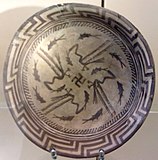Samarra-beskawing
| Samarra-beskawing | ||

| ||
| Die Samarra-beskawing (pers) naas dié van Hassuna, Halaf en Obeid. | ||
| Streek | Mesopotamië | |
| Tydperk | Neolitikum | |
| Datums | c. 5500-4800 v.C. | |
| Tipeterrein | Samarra | |
| Belangrike terreine | Tell Shemshara, Tell es-Sawwan | |
| Voorafgegaan deur | Neolitikum B voor erdeware, Hassuna-beskawing, Halaf-beskawing | |
| Opgevolg deur | Obeid-tydperk | |
Die Samarra-beskawing is ’n prehistoriese argeologiese kultuur in Noord-Mesopotamië wat rofweg van 5500 v.C. tot 4800 v.C. geduur het. Dit oorvleuel gedeeltelik met die Hassuna- en vroeë Obeid-tydperk. Die Samarra-kultuur is die eerste keer gedefinieer tydens uitgrawings deur die Duitse argeoloog Ernst Herzfeld by die Samarra-terrein. Ander terreine waar Samarran-materiaal ontdek is, sluit in Tell Shemshara, Tell es-Sawwan en Yarim Tepe.[1]
By Tell es-Sawwan getuig bewyse van besproeiing van ’n vooruitstrewende gevestigde kultuur met ’n hoogs georganiseerde sosiale struktuur. Die kultuur is veral bekend vir sy fyn erdeware wat met diere, insluitende voëls, en geometriese patrone op ’n donker agtergrond versier is. Dié algemeen uitgevoerde soort erdeware, een van die eerste wydverspreide, relatief uniforme erdewarestyle in die antieke Nabye Ooste, is eerste by Samara gesien.
Die Samarran-beskawing was ’n voorloper van die Mesopotamiese kultuur van die Obeid-tydperk. By Tell Sabi Abyad en ander laat Neolitiese terreine in Sirië gebruik geleerdes vae terme soos Samarra-beïnvloed of Samarra-verwant, omdat verhoudings met die tradisionele Samarra-hartland nie verstaan word nie. Die term kan uitgebrei word om terreine in Sirië soos Tell Chagar Bazar, Tell Boueid II, Tell Sabi Abyad of Tell Halula in te sluit – hier word soortgelyke erdeware in Pre-Halaf- tot Vroeë Halaf-oorgangsverband tans uitgegrawe.
Artefakte
[wysig | wysig bron]-
Bak uit die Samarra-tydperk, omstreeks 6200-5700 v.C.
-
Vrouefiguur wat by Tell es Sawwan, naby Samarra, ontdek is, omstreeks 6000 v.C.
-
Stukke Samarra-erdeware.
-
Samarra-bak, omstreeks 4000 v.C.
Verwysings
[wysig | wysig bron]- ↑ Blackham, Mark (1996). "Further Investigations as to the Relationship of Samarran and Ubaid Ceramic Assemblages". Iraq. 58: 1–15. doi:10.1017/S0021088900003144. JSTOR 4200416.
Skakels
[wysig | wysig bron] Wikimedia Commons het meer media in die kategorie Samarra-beskawing.
Wikimedia Commons het meer media in die kategorie Samarra-beskawing.
 Hierdie artikel is in sy geheel of gedeeltelik uit die Engelse Wikipedia vertaal.
Hierdie artikel is in sy geheel of gedeeltelik uit die Engelse Wikipedia vertaal.
Text is available under the CC BY-SA 4.0 license; additional terms may apply.
Images, videos and audio are available under their respective licenses.




